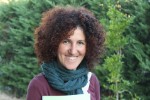Biologist specialising in the conservation biology of threatened species
I studied biological sciences, specializing in zoology, with electives botanical (plant sociology), and paleontology (Human Paleontology, Paleontology Mammals and Biology of Human Populations) at the Complutense University of Madrid.
Diplôme Approfondi langue française, C1 DALF Ministère de l'education nationalle.
In 1998 I got a scholarship as a research assistant in the project “parameters to measure biodiversity and its change” funded by CONABIO (National Commission for the Knowledge and Use of Biodiversity) and CYTED (Ibero-American Science and Technology for Development) at the Institute of Ecology A., C., Veracruz (Mexico). From that moment began my interest in real and practical application of scientific knowledge of the species in its own preservation. I am interested in conservation biology, dissemination of knowledge and access this knowledge to the general public.
I started working in Navarra in 2000 in different projects on management and conservation of biodiversity; forest management and grazing management; related with threatened wildlife.
Since 2010, I combine my work with the Department of Education (Government of Navarra), as a professor of natural sciences, French and Spanish for foreigners.
I realize French – Spanish, Spanish – French technical translations on issues related to the environment.
Since 2011 till now, I am co-founder of Bioma Forestal where I deal mainly studies of fauna.
PUBLICATIONS AND WORKSHOP COMUNICATIONS
Emerging conflits for the environmental use of water in high-valuable rangelands. Can livestock water ponds be managed as artificial wetlands for amphibians? Ecological Engineering 37. (2011): 1443-1452. Rosa M Canals. Vicente Ferrer, Ana Iriarte, Susana Cárcamo, Leticia San Emeterio, & Eva Villanueva. Canals et al., 2011(2).
Capítulo: “Bosques viejos y árboles viejos: importancia para la fauna”. SCHWENDTNER, O. & CÁRCAMO, S. Del libro: “Gestión y conservación de fauna silvestre”. IV Encuentro del día forestal mundial. Ponencias. Ponferrada, 2009.
Capítulo: “Conservación de las poblaciones de tejo en Navarra. Propuesta de un Plan de Gestión”. MIÑAMBRES, L., SCHWENDTNER, O. & CÁRCAMO, S. Del libro: “El tejo (Taxus baccata) en el Mediterráneo Occidental”. Generalitat Valenciana, Consellería de Territori y Habitage, Proyecto LIFE “Hábitats de alta montaña” y Caja de ahorros del Mediterráneo. 2007
Evolución de las poblaciones de pito negro (Dryocopus martius) y pico dorsiblanco (Dendrocopos leucotos lilfordi) en los Montes de Quinto Real, (Navarra) y su relación con la gestión forestal. Pirineos 161; 133 a 150 (2006). Instituto Pirenaico de Ecología, Jaca. CÁRCAMO, S.
Forest management considerations for conservation of Black Wooddpecker (Dryocopus martius) and White-backed Woodpecker (Dendrocopos leucotos lilfordi) populations in Quinto Real. (Spanish western Pyrenees). Biodiversity and Conservation (2006) 15: 1399-1415. GARMENDIA, A., CÁRCAMO, S. & SCHWENDTNER, O.
Anuros trepadores en un bosque caducifolio del norte ibérico. VIII Congreso Luso-Español de Herpetología, Málaga 13-17 de julio 2004. GOSÁ, A., SARASOLA, V. & CÁRCAMO, S.
Estado actual de una población reintroducida de rana ágil en un espacio protegido de Navarra. VIII Congreso Luso-Español de Herpetología, Málaga 13-17 de julio 2004. SARASOLA, V., GOSÁ, A. & CÁRCAMO, S.
Papel de las islas de bosque maduro en la conservación de la biodiversidad dentro de un monte en explotación. Symposium de Ecología Insular. La Palma 18-23 noviembre 2002. SCHWENDTNER, O. & CÁRCAMO, S.
Situación de las subpoblaciones de rana ágil (Rana dalmatina) en Navarra. Symposium de Ecología Insular. La Palma 18-23 noviembre 2002. CÁRCAMO, S & GOSÁ, A.
Actuaciones encaminadas a la conservación de la rana ágil (Rana dalmatina) en Navarra. VII Congreso Luso-Español de Herpetología. Évora, Portugal 3-5 octubre 2002. GOSÁ, A. & CÁRCAMO, S.
White-backed woodpecker as a key-species for monitoring forest biodiversity. IUFRO Conference, 4-6 December 2001 in Palermo (Sicily). SCHWENDTNER, O. & CÁRCAMO, S.
Conservación de pico dorsiblanco y pito negro en un hayedo atlántico gestionado. Actas III Jornadas de aves cantábricas. Bilbao 12 - 14 octubre de 2001. CÁRCAMO, S., GARMENDIA, A. & SCHWENDTNER, O.
Influencia de los tratamientos selvícolas en la capacidad de acogida de un hayedo atlántico para pito negro y pico dorsiblanco. III Congreso Forestal Español. Granada Septiembre 2001. CÁRCAMO, S., GARMENDIA, A. & SCHWENDTNER, O.
Las tejedas de Navarra. Ecología, dinámica y conservación. III Congreso Forestal Español. Granada Septiembre 2001. SCHWENDTNER, O., CÁRCAMO, S., LARRAÑAGA, A.,MIÑAMBRES, L. & REMÓN, J. L.
Caracterización ecológica de los bosquetes de tejo (Taxus baccata) del extremo sur-occidental del Pirineo. VI Coloquio Internacional de Botánica pirenaico - cantábrica. Barruera (Lérida) Julio 2001. MIÑAMBRES, L., CÁRCAMO, S. & SCHWENDTNER, O.
Las tejedas de Quinto Real: formaciones forestales relícticas. Gorosti, Revista de Ciencias de Navarra, nº16 (7). Febrero 2001. SCHWENDTNER, O. & CÁRCAMO, S.



